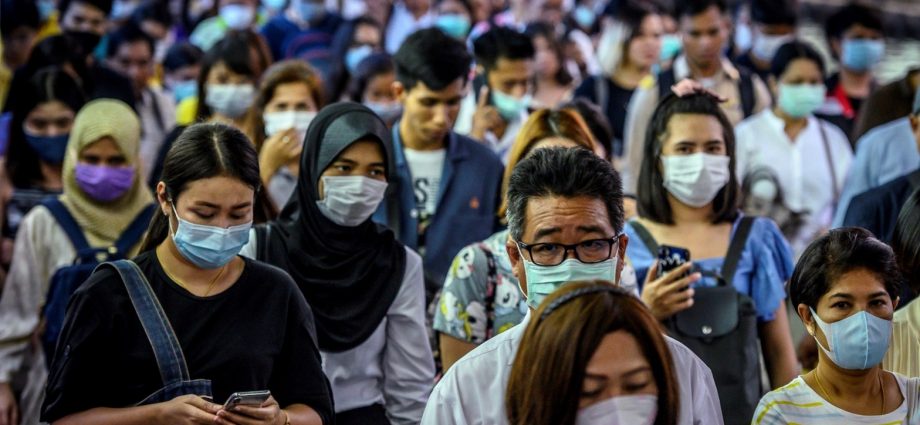Southeast Asia’s second-largest and once one of its most dynamic economies is struggling under the weight of an aging population, a deteriorating education system and low-yield rice farming. Thailand looks trapped as a middle-income country, unable to get rich, and stuck between a younger, dynamic Vietnam and a larger Indonesia.
Getting out of its economic rut won’t be easy, but investment in education and higher quality human capital and agricultural and governance reform should be priorities.
Thailand has the lowest fertility rate in Southeast Asia, bar Singapore. Its demographics are arguably more worrisome than those of South Korea, which has a fertility rate close to 0.8. Between 2000 and 2021, South Korea’s population aged 20–24 declined by 15%.
In Thailand, that number fell by 20%, moderately better than the 27% decline in Japan. But Japan and South Korea generate over four times the per capita GDP of Thailand, and they have more resources to support aging citizens and attract skilled immigrants to reinforce greying workforces.
As in many other countries, Covid-19 exacerbated Thailand’s aging. Between 2020 and 2021, the number of Thai infants declined by 8%. Middle and working-class households, stressed by growing debt, inflation and poor employment prospects, are hardly eager to have more children. During the pandemic, Thai household debt soared to 90% of GDP.
In the 2000s, Thailand outperformed its regional peers across many education metrics. Nearly all age-eligible children attended primary school and a high proportion of young people entered junior secondary school. Most Thai workers in 2006 had a primary school education at best. By 2019 most had some post-primary education.

These gains in education and skills can help ameliorate the effects of rapid aging. But vital to human capital formation and breaking out of the middle-income trap is the uptake and quality of higher education. Over the past decade, declines in university enrolments have begun outpacing the demographic decline in the numbers of young people.
Thailand’s gross tertiary enrolment ratio — the number enrolled in tertiary education over the main tertiary level age cohort — peaked at around 50% in the early 2010s and then fell toward 40–45% in recent years. Technical or vocationally oriented programs fared better, but most general university programs lost many students. Between 2015 and 2019, undergraduate degree enrolments fell by a sharp 18%.
Thai universities’ problems relate to quality, jobs and household finances. With fewer enrolments, universities have fewer resources and incentives to invest in improving quality in the way that Chinese or Singaporean universities have done. In turn, graduate employment prospects have weakened. The wage premium of Thai tertiary education has fallen since the early 2010s, with many graduates underprepared for the workforce.
During the pandemic, the number of unemployed college-educated workers more than doubled. For debt-laden households, the extra years of university education might no longer seem worthwhile. Many Thai universities are faced with eliminating programs or closing altogether.
Agriculture, still a major pillar of the Thai economy, is another worry. The sector contributes around one-tenth of Thailand’s GDP but employs around one-third of the labor force. While the sector has diversified toward fruit and animal husbandry, rice remains a core crop — Thai farms account for 14% of the international rice trade.
Yet, Thailand’s rice farms are not very productive or efficient. Thailand’s average yields are now lower than those of Vietnam, Cambodia and Laos. The average Thai rice farm is too small and farmers too poor or elderly for investments in the equipment or infrastructure to improve productivity.
These challenges have prompted policymakers to pivot to relying on new industrial technology to resuscitate economic growth. For instance, political leaders dream of a shift to electric vehicle manufacturing, and, in May 2022, Prime Minister Prayut Chan-ocha expressed hope that Thailand would become the world’s largest electric vehicle production hub.
But a purely national strategy focussed on electric vehicles would be a costly gamble, in a region where few consumers can afford the technology in the first place.

Thailand, and its auto industry in particular, benefits from large investments from Japan and China. Thailand’s exports have performed well since 2020, with rising vehicle sales to Japan and agricultural exports to China. Foreign investment-driven trade has given a strong economic boost and opened opportunities for structural change.
But foreign investment is discouraged by an uncertain legal and political environment, corruption, powerful domestic oligopolies and restrictions on foreign ownership. The Eastern Economic Corridor (EEC) and the special economic zones created under recent governments have yet to broaden or deepen investments into Thailand.
Rejuvenation of higher education requires reform of higher education financing, the consolidation and internationalization its universities.
Alleviating stagnation in agriculture requires a pivot from agricultural price supports toward mechanization, investment in irrigation and farm consolidation.
The challenges of Thailand’s demography, education and agriculture seem symptomatic of an unequal economy with concentration of resources and power around large conglomerates and the wealthy.
Such an economic structure restrains middle-class demand and increases capital outflows to nearby countries like Vietnam, even while Thailand has too little domestic private investment. Likewise, there are too few incentives for students or farmers to upgrade capabilities and few supports for families to have children.
Changing direction is at heart a governance and political problem. Many Thailand 4.0 proposals — for example, for regionally-balanced investment and joint partnerships to direct resources into higher education — show there’s no shortage of good ideas from Thai civil servants and scholars about what is needed. But implementing them is another question.
Richard Yarrow is Fellow at the Mossavar-Rahmani Center at the Harvard Kennedy School, Visiting Research Fellow at the East Asian Bureau of Economic Research at the ANU, and Visiting Research Fellow at the East Asian Institute at NUS. He recently published the monograph Thailand’s Economic Dilemmas in Post-Pandemic Asia.
This article, republished with permission, was first published by East Asia Forum, which is based out of the Crawford School of Public Policy within the College of Asia and the Pacific at the Australian National University.

